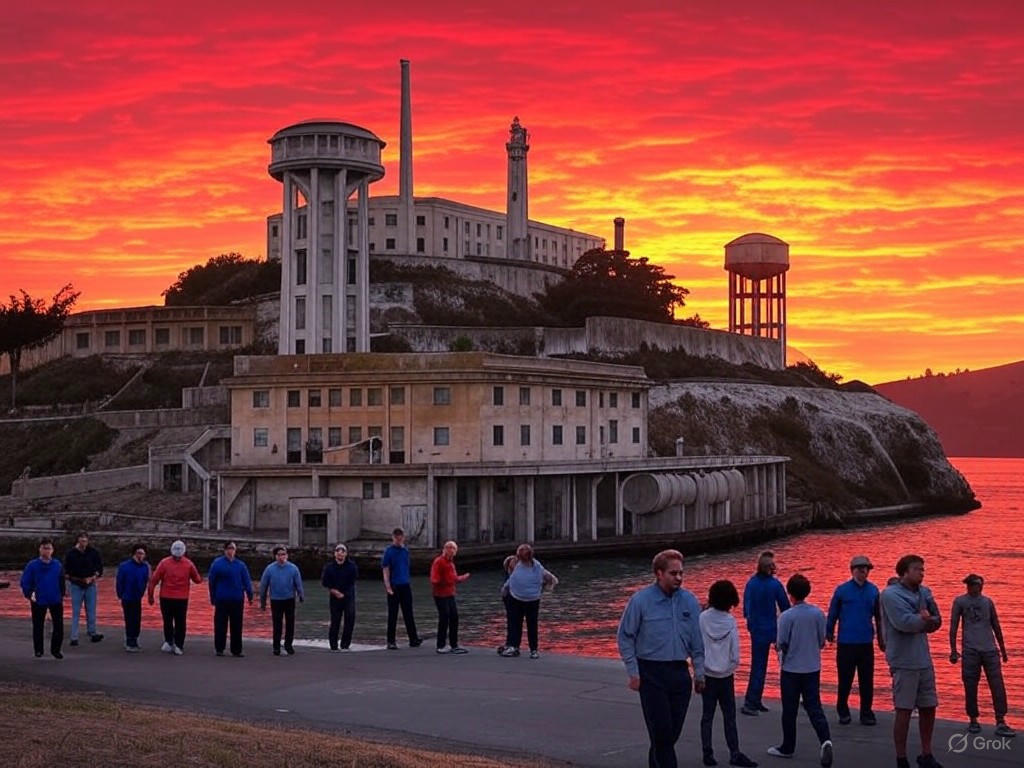
Alcatraz Reopening: Trump Orders Historic Prison Revival
The Buzz Around Alcatraz Reopening
In a move that’s stirring up conversations across the nation, President Donald Trump announced on May 4, 2025, his plan to bring Alcatraz back from its days as a tourist spot to a fully operational high-security prison. Alcatraz reopening isn’t just about dusty history; it’s a bold statement on tackling violent crime head-on. This directive has federal agencies gearing up to transform the San Francisco Bay icon into a modern facility for America’s toughest offenders.
Imagine the island, once echoing with tales of notorious inmates, now symbolizing a renewed commitment to safety and order. Trump’s announcement on Truth Social has people debating whether this is a smart revival or a step back in time. What do you think—could Alcatraz reopening really make a difference in today’s criminal landscape?
What’s Driving the Alcatraz Reopening Directive?
President Trump’s directive is clear and unapologetic, ordering the Bureau of Prisons, Department of Justice, FBI, and Department of Homeland Security to collaborate on this project. Alcatraz reopening represents a shift toward stricter law enforcement, targeting repeat violent criminals who Trump describes as “the dregs of society.”
During a White House briefing, he emphasized it as “a symbol of law and order,” linking it to broader policies on crime and immigration. This isn’t just about building walls; it’s about reinforcing the idea that justice means consequences. For anyone following Trump’s policies, Alcatraz reopening feels like a throwback to his first term’s tough stance.
Experts are already weighing in, with some seeing it as a necessary deterrent. Have you ever wondered how historical sites like this could pivot to serve modern needs?
Federal Agencies Respond to Alcatraz Reopening Plans
The Bureau of Prisons has confirmed they’ll follow through, but the road ahead is full of hurdles. Alcatraz reopening involves enlarging and rebuilding a site that’s been a National Historic Landmark since 1963. We’re talking about logistical challenges like timelines, costs, and even environmental reviews.
Key questions remain unanswered: How much will this cost taxpayers, and what’s the plan for the island’s unique location? A Bureau spokesperson noted that more details are coming, but for now, it’s all about coordination with local authorities in San Francisco. This could be a game-changer for the federal prison system, yet it raises flags about feasibility.
- Projected renovation timeline
- Budget estimates for rebuilding
- Security setups for high-risk inmates
- Environmental impacts on the bay
- Local community involvement
Challenges in Implementing Alcatraz Reopening
One major hurdle with Alcatraz reopening is the sheer expense. Back in the 1960s, the prison shut down because it was too costly to maintain on an isolated island. Today, factors like water transport and weather damage could drive up prices even more.
Plus, modern standards for inmate rights and accessibility mean this won’t be a simple facelift. Think about it: We’re dealing with a site that’s drawn 1.5 million tourists yearly—how do you balance that with security needs? It’s a puzzle that could shape the future of Alcatraz reopening efforts.
Looking Back at Alcatraz’s History
Alcatraz Federal Penitentiary has a storied past, operating from 1934 to 1963 as a fortress for legends like Al Capone and the Birdman. Its reputation as an escape-proof prison made it infamous, though mysteries like the 1962 breakout still captivate people. Alcatraz reopening brings this history full circle, turning a faded relic into a symbol of resolve.
The government closed it originally due to high costs, opting for mainland alternatives. Now, as a National Park staple, its shift could disrupt the tourism scene. But isn’t it fascinating how places like this evolve with the times?
Connections to Immigration and Policy Shifts
Trump’s push for Alcatraz reopening ties into his immigration agenda, where he criticizes judicial delays in deportations. He argues it’s time to stop “being held hostage to criminals and judges,” making this more than just a prison revival—it’s part of a larger law-and-order push.
This approach echoes his past policies, aiming to house illegal entrants with violent records. For readers interested in criminal justice reform, Alcatraz reopening highlights ongoing debates about enforcement versus rehabilitation. Could this be the spark for new discussions on balancing security and fairness?
The Symbolic Power of Alcatraz Reopening
Beyond the logistics, Alcatraz reopening carries deep symbolic weight. It’s not every day a president revives a myth-like prison to stand for justice. Trump calls it a beacon of “Law, Order, and JUSTICE,” reinforcing his brand of tough governance.
In a hypothetical scenario, picture families visiting the island years ago, now imagining it as a high-security hub. This kind of transformation could influence public perception, making Alcatraz reopening a talking point for years.
Economic Impacts of Alcatraz Reopening
The economic side of Alcatraz reopening is complex. On one hand, it could boost jobs in construction and security; on the other, it might hurt tourism revenue that’s been a Bay Area staple. Local businesses are already voicing concerns about losing visitors.
Weighing the pros and cons, experts suggest comparing costs to expanding existing prisons. If done right, Alcatraz reopening might even blend tourism with education, like guided tours on its history. What strategies could make this work without alienating the community?
Expert Views on Alcatraz Reopening
Criminal justice pros are split on Alcatraz reopening. Supporters see it as a strong deterrent for violent crimes, while reformers worry about outdated methods and rehab opportunities. Key issues include how it fits with today’s emphasis on prisoner rights and alternatives to incarceration.
For instance, a study from the Politico analysis highlights potential mismatches with modern standards. As you read this, consider: Is Alcatraz the right symbol for 21st-century justice?
Broader Initiatives Alongside Alcatraz Reopening
Trump didn’t stop at prisons; he also announced tariffs on foreign films, showing a pattern of bold economic moves. This pairing underscores his vision for America-first policies, with Alcatraz reopening as a key piece.
It’s like watching a puzzle come together—each initiative builds on the last. For those tracking policy trends, this could signal more changes ahead in both justice and trade.
What’s Next for Alcatraz Reopening?
Moving forward, expect budget proposals, environmental checks, and possible legal battles. The Bureau of Prisons will lead, but timelines are still unclear. Alcatraz reopening might not happen overnight, given the scope.
Key steps include engaging locals and finalizing security plans. Stay tuned, as this could redefine how we handle high-profile offenders.
A Fresh Take on Justice
In wrapping up, Alcatraz reopening is more than a policy—it’s a statement on America’s approach to crime. Whether it succeeds or faces setbacks, it’s bound to spark debate. If you’re passionate about these issues, share your thoughts in the comments below.
We’d love to hear your ideas on how this could play out. Feel free to explore more on our site or share this post with friends who care about criminal justice reform.
References
1. Axios. (2025). Trump orders rebuild and reopen of Alcatraz prison. https://www.axios.com/2025/05/05/trump-alcatraz-prison-rebuild-reopen
2. Politico. (2025). Trump announces Alcatraz revival and movie tariffs. https://www.politico.com/news/2025/05/04/trump-alcatraz-movies-tariffs-00326220
3. Other sources referenced in analysis: OSF, Princeton, ASU, GitHub, MIT (general research repositories).
Alcatraz reopening, Trump prison policy, criminal justice reform, federal prison system, law and order, high-security prison revival, violent offenders, San Francisco Bay prison, Trump law enforcement, historic prison transformation






